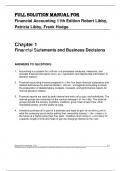Exam (elaborations)
Solution Manual for Financial Accounting 11th Edition Robert Libby, Patricia Libby, Frank Hodge
Solution Manual for Financial Accounting 11th Edition Robert Libby, Patricia Libby, Frank Hodge With Appendix A Solutions Manual & MBA Supplement Solutions Manual
[Show more]



